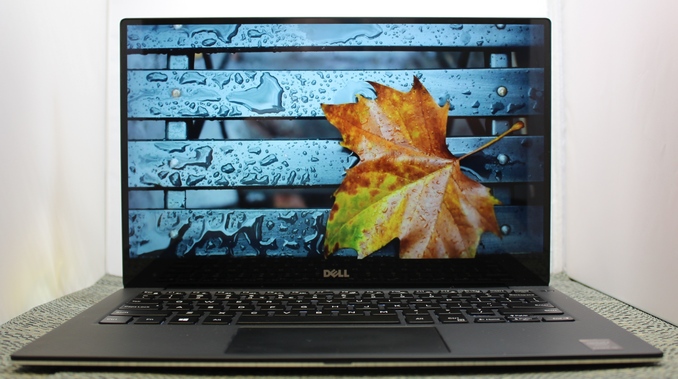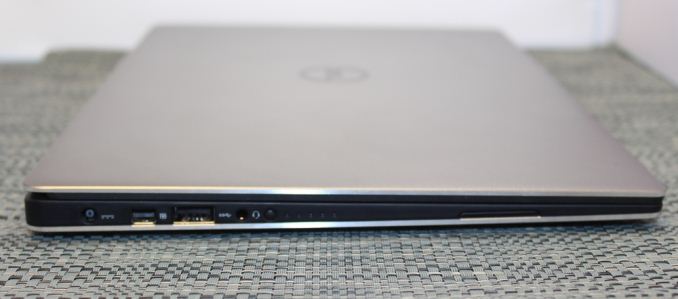Dell XPS 13 Review
by Brett Howse on February 19, 2015 9:00 AM EST- Posted in
- Laptops
- Dell
- Ultrabook
- Broadwell-U
- XPS 13

Dell launched the 2015 version of their XPS 13 at CES in January, and it made a big impression because of something that was very small. The first thing you see when you look at the XPS 13 is how small the bezels are around the display. At 5.2 mm, they are easily the thinnest display bezels on any laptop made today. Dell claims the XPS 13 is a 13 inch display in the chassis of an 11 inch notebook, and while they have made that claim before, for 2015, it would be hard to argue with them. But the XPS 13 is more than just a display, and Dell has outfitted it with some very modern hardware to give us our first look at an Ultrabook based on the just launched Intel 5th Generation processors, Broadwell-U.
At CES, Dell also told me that the new XPS 13 would have great battery life, with the company claiming that it would get up to fifteen hours. That claim seems hard to believe, with our battery life test topped at just a hair under ten hours by the current leader, the MacBook Air 13. However, this will be our first look at a laptop running on the new 14 nm process from Intel, so we can get a chance to see just how power efficient the new processors are.
Dell is offering quite an arrangement of options as well, allowing the new XPS 13 to fit into a lot more budgets than some of the other premium notebooks around. The base model comes with the Intel Core i3-5010U processor, but if you need more speed you can upgrade to the i5-5200U or i7-5500U. All of the storage options are solid state drives, which is great to see. The base is 128GB, and optional upgrades are to 256GB or 512GB. Memory choices are dual-channel 4GB DDR3L-RS-1600, or a dual-channel 8GB option.
We received two models for testing, with the first being a Core i5-5200U with the 1920x1080 non-touch display, 4GB of memory, and a 128GB SSD, which lists for $900. The second model is the Core i5-5200U, with 2x4GB of memory, a 256GB SSD, and the 3200x1800 touch display. This model lists at $1400.
Update: Originally I had listed the 4 GB model as single channel, but it is actually 2 x 2 GB for dual channel. Sorry for the mistake.
| Dell XPS 13 9343 Specifications | |
| Processor | Intel Core i3-5010U (Dual-core + HT 2.1GHz 3MB L3 14nm 15W TDP) Intel Core i5-5200U - model tested (Dual-core + HT 2.2-2.7GHz 3MB L3 14nm 15W TDP) Intel Core i7-5500U (Dual-core + HT 2.4-3.0GHz, 4MB L3, 14nm, 15W TDP) |
| Chipset | Broadwell-ULT |
| Memory | 2 x 2GB or 2 x 4GB DDR3L-RS-1600 (Dual Channel 8GB Max) |
| Graphics | Intel HD 5500 (23 EUs at 300-900MHz on Core i3) (24 EUs at 300-900MHz on Core i5) (24 EUs at 300-950MHz on Core i7) |
| Display | 13.3" Anti-Glare IPS 16:9 FHD (1920x1080) (Sharp 1420 Panel) 13.3" Glossy IPS 16:9 QHD+ (3200x1800) IGZO2 (Sharp 1421 Panel with Corning Gorilla Glass NBT and Touchscreen) |
| Storage | 128GB/256GB/512GB SSD (Samsung PM851 M.2 2280) |
| Optical Drive | N/A |
| Networking | Dell Wireless 1560 plus Bluetooth 4.0 - model tested (2x2:2 802.11ac 867Mbps capable Broadcom) Intel Dual Band Wireless-AC 7265 plus Bluetooth 4.0 (2x2:2 802.11ac 867Mbps capable) Intel Dual Band Wireless-N 7265 plus Bluetooth 4.0 (2x2:2 802.11n 300Mbps capable) |
| Audio | Realtek HD Stereo Speakers professionally tuned with Waves MaxxAudio Pro 1w x 2 Headset jack |
| Battery/Power | 52Wh non-removable 45W Max AC Adapter |
| Front Side | Charge Light |
| Left Side | Headset Jack Battery Meter 1 x USB 3.0 with PowerShare 1 x mini DisplayPort Speaker AC Power Connection |
| Right Side | Noble Lock Slot 1 x USB 3.0 with PowerShare SD Card Slot Speaker |
| Back Side | N/A |
| Operating System | Windows 8.1 64-bit |
| Dimensions | 11.98" x 7.88" x 0.33-0.6" (WxDxH) (304mm x 200mm x 9-15mm) |
| Weight | 2.6 lbs (1.18kg) Non-Touch 2.8 lbs (1.27kg) Touch |
| Extras | 720p HD Webcam Backlit Keyboard |
| Colors | Silver |
| Pricing | $800 (i3, 4GB, 128GB, FHD) $900 (i5, 4GB, 128GB, FHD) - model tested $1000 (i5, 8GB, 128GB, FHD) $1300 (i5, 8GB 128GB, QHD+) $1400 (i5, 8GB, 256GB, QHD+) - model tested $1600 (i7, 8GB, 256GB, QHD+) $1900 (i7, 8GB, 512GB, QHD+) |
The display has some choices as well. The base model comes with a 13.3 inch 1920x1080 IPS display, with a matte finish, and no touch capabilities. This is still a respectable 165 pixels per inch, and is a good option to keep the costs down. The upgraded display is quite the upgrade. Dell has worked with Sharp to outfit the XPS 13 with an optional 3200x1800 resolution IGZO panel, which features Corning Gorilla Glass NBT over the top, along with ten-point multitouch. This works out to 272 pixels per inch, and the IGZO panel is a full RGB stripe.
There are a couple of other options as well, such as a range of wireless adapters, with the Dell 1560 outfitted on the review laptops that we received. This is a Broadcom wireless adapter, with 802.11ac support. Some of the options, like the 512GB drive, are only available with the top CPU and upgraded display. Dell does offer some degree of flexibility when ordering, but not all options are available for all devices.
Dell has crafted a fine looking laptop, with some new parts from Intel and Sharp paving the way. On paper this is a great start, so let's get into the finer details.











201 Comments
View All Comments
trane - Thursday, February 19, 2015 - link
This must deserve an Editor's Choice award?The only major drawback is the auto-brightness, which I'm sure will be fixed with an update soon. IINM, the original Acer S7 had a similar issue which they fixed with a firmware update. Once that is fixed, I don't think there's any real con! Yes, we would all love it to do Yoga style acrobatics, and have touch for $800, but let's be realistic. Even with the battery life hit the QHD+ option is still class leading! Dell can't fight the the current state of technology...
But the fact that these are brought up as shortcomings just tell us how great this laptop is. I mean, no one's complaining that the $1000 Macbook Air sports an archaic non-touch non-matte low-res TN panel.
Some other sites seem to be reporting much lower battery life versus Macbook Air. I wonder if that is because they are penalising the display for being brighter? Or using Chrome? Chrome has godawful efficiency right now with Hi DPI support, I'm surprised that this is not more commonly known! My laptop does 8 hours with IE, 5 with Chrome.
RT81 - Thursday, February 19, 2015 - link
Believe me, PLENTY of people are complaining about the screen on the current Macbook Air. Nobody cares about touch on a Mac, but they certainly care about the TN and low-res part.repoman27 - Thursday, February 19, 2015 - link
"The FHD model (1920x1080) arrived with a single 4GB memory module and the QHD+ version came with 2x4GB, which gives us the chance to check the performance differences between the single-channel memory and dual-channel memory."These machines are memory down (soldered RAM) configurations. There are no modules, and Lenovo would be insane to not keep both channels populated and simply use different density packages for the different models. Are you sure they're shipping single channel setups?
repoman27 - Thursday, February 19, 2015 - link
D'oh! Dell, not Lenovo.Brett Howse - Thursday, February 19, 2015 - link
Sorry I made a mistake there. It is in fact 2x2GB and the article has been updated.Hulk - Thursday, February 19, 2015 - link
Is it possible that Dell sent the laptops without the ability to change auto brightness on purpose so that the battery life tests would be extraordinarily high? I'm sure they'll be good when the update to turn auto brightness off arrives but most people will remember the hype of the original amazing battery life tests. With all due respect to Anandtech I think they should not have posted battery life tests until they auto brightness can be turned off. It's not really an apples-to-apples (no pun intended) comparison.trane - Thursday, February 19, 2015 - link
To be fair, he did check the brightness from time to time. If there were any notable changes I'm sure they would have withheld the results.Hulk - Thursday, February 19, 2015 - link
You are right and I'm not in ANY way implying there was an bias on Anandtech's part. It's a tough call. Publish the battery life to get the results out there quickly for readers with the caveat of not being able to disable auto brightness or just write "the battery life results look to be very impressive but we are not going to publish them until we can disable auto brightness." I'm just saying I would have gone with the 2nd option for two reasons. First, if with auto brightness off the results are dramatically lower than Dell pulled one over. And second, to send a message to manufacturers that if they don't allow fair comparisons due to locked software not all testing results will be published.As I wrote above it's a tough call and I respect Anandtech's decision I just disagree with it.
andrewaggb - Thursday, February 19, 2015 - link
The battery results are fantastic, I wonder how much the auto-brightness plays into it. I wonder if you pointed a bright light at the light sensor if that would force the brightness to stay at maximum.JarredWalton - Thursday, February 19, 2015 - link
FWIW, I've run tests with laptops at 100 nits before just to see how much that would help. The difference between 100 and 200 nits is usually on the order of 30-60 minutes at most, and often less. However, to get 15 hours from a 42Wh battery means that the laptop is using around 2.74W in our Light workload. If the display adaptive brightness saves 1W, battery life would drop to 11.24 hours (give or take). Which is what happens with the QHD+ panel I should note, though how much of that is the display alone and how much is caused by a higher load on RAM and CPU/GPU to handle the higher resolution is difficult to say.